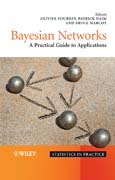
Bayesian networks: a practical guide to applications
Pourret, Olivier
Naim, Patrick
Marcot, Bruce
The first book to focus on BBNs practical applications, Bayesian Belief Networks: A Practical Guide to Applications defines and introduces BBNs, demonstrating how they can be used to forecast, explain, make decisions, and represent knowledge in the context of complex and uncertain systems. The book then provides step-by-step guidelines, specifying model structure and probabilities, tips, cautions and caveats, and model validation. The largest part of the text consists of 20 application chapters demonstrating each type of application in each field in which BBNs are used. The book concludes with a review of the applications, a summary of the lessons learned, and a discussion of the future of the area. INDICE: 1. Introduction. 1.1 Models. 1.2 Probabilistic vs. deterministic models. 1.3 Unconditional and conditional independence. 1.4 Bayesian networks. 2. Medical diagnosis. 2.1 Bayesian networks in medicine. 2.2 Context and history. 2.3 Model construction. 2.4 Inference. 2.5 Model validation. 2.6 Model use. 2.7 Comparison to other approaches. 2.8 Conclusions and perspectives. 3. Clinical decision support. 3.1 Introduction. 3.2 Models and methodology. 3.3 The Busselton network. 3.4 The PROCAM network. 3.5 The PROCAM Busselton network. 3.6 Evaluation. 3.7 The clinical support tool: TakeHeartII. 3.8 Conclusion. 4. Complex genetic models. 4.1 Introduction. 4.2 Historical perspectives. 4.3 Complex traits. 4.4 Bayesian networks to dissect complex traits. 4.5 Applications. 4.6 Future challenges. 5. Crime risk factors analysis. 5.1 Introduction. 5.2Analysis of the factors affecting crime risk. 5.3 Expert probabilities elicitation. 5.4 Data preprocessing. 5.5 A Bayesian network model. 5.6 Results. 5.7 Accuracy assessment. 5.8 Conclusions. 6. Spatial dynamics in geography. 6.1 Introduction. 6.2 An indicator-based analysis. 6.3 The Bayesian network model. 6.4 Conclusions. 7. Inference problems in forensic science. 7.1 Introduction. 7.2 Building Bayesian networks for inference. 7.3 Applications of Bayesian networks in forensic science. 7.4 Conclusions. 8. Conservation of a threatened bird. 8.1 Context/History. 8.2 Model construction. 8.3 Model calibration, validation and use. 8.4 Conclusions/Perspectives. 9. Classifiers for modelling of mineral potential. 9.1 Mineral potential mapping. 9.2 Classifiers for mineral potential mapping. 9.3 Bayesian network mapping of base metal deposit. 9.4 Discussion. 9.5 Conclusions. 10. Student modelling. 10.1 Introduction. 10.2 Probabilistic relational models. 10.3 Probabilistic relational student model. 10.4 Case study. 10.5 Experimental evaluation. 10.6 Conclusions and future directions.11. Sensor validation. 11.1 Introduction. 11.2 The problem of sensor validation. 11.3 Sensor validation algorithm. 11.4 Gas turbines. 11.5 Models learned and experimentation. 11.6 Discussion and conclusion. 12. An Information Retrieval system. 12.1 Introduction. 12.2 Overview. 12.3 Bayesian networks and information retrieval. 12.4 Theoretical foundations. 12.5 Building the Information Retrieval system. 12.6 Conclusion. 13. Reliability analysis of systems. 13.1 Introduction. 13.2 Dynamic fault trees. 13.3 Dynamic Bayesian networks. 13.4 A case study: the Hypothetical Sprinkler System. 13.5 Conclusions. 14. Terrorism risk management. 14.1 Introduction. 14.2 The Risk Influence Network. 14.3 Software implementation. 14.4 Site Profiler deployment. 14.5 Conclusion. 15. Credit-rating of companies. 15.1 Introduction. 15.2 Naive Bayesian classifiers. 15.3 Example of actual credit-ratings systems. 15.4 Credit-rating data. 15.5 Numerical experiments. 15.6 Performance comparison of classifiers. 15.7 Conclusion. 16. Classification of wines. 16.1 Introduction. 16.2 Experimental setup. 16.3 Feature extraction methods. 16.4 Classification results. 16.5 Conclusions. 17. Pavement and bridge management. 17.1 Introduction. 17.2 Pavement Managementdecisions. 17.3 Bridge Management. 17.4 Bridge approach embankment - Case study. 17.5 Conclusion. 18. Complex industrial process operation. 18.1 Introduction. 18.2 A methodology for Root Cause Analysis. 18.3 Pulp and paper application. 18.4 The ABB Industrial IT Platform. 18.5 Conclusion. 19. Probability of default for large corporates. 19.1 Introduction. 19.2 Model construction. 19.3 BayesCredit. 19.4 Model benchmarking. 19.5 Benefits from technology and software. 19.6 Conclusion. 20. Risk management in robotics. 20.1 Introduction. 20.2 DeepC. 20.3 The ADVOCATE II architecture. 20.4 Model development. 20.5 Model usage and examples. 20.6 Benefits from using probabilistic graphical models. 20.7 Conclusion. 21. Enhancing Human Cognition. 21.1 Introduction. 21.2 Human foreknowledge in its everyday settings. 21.3 Machine foreknowledge. 21.4 Current application and future research needs. 21.5 Conclusion. 22. Conclusion. 22.1 An Artificial Intelligence perspective. 22.2 A rational approach of knowledge. 22.3 Future challenge.
- ISBN: 978-0-470-06030-8
- Editorial: John Wiley & Sons
- Encuadernacion: Cartoné
- Páginas: 432
- Fecha Publicación: 21/03/2008
- Nº Volúmenes: 1
- Idioma: Inglés
